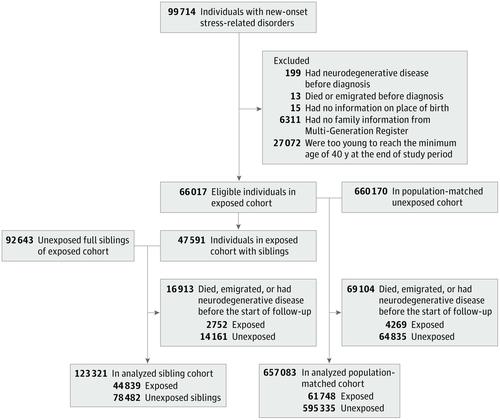JAMA Neurology ( IF 20.4 ) Pub Date : 2020-06-01 , DOI: 10.1001/jamaneurol.2020.0117 Huan Song 1, 2, 3 , Johanna Sieurin 3 , Karin Wirdefeldt 3, 4 , Nancy L Pedersen 3, 5 , Catarina Almqvist 3, 6 , Henrik Larsson 3, 7 , Unnur A Valdimarsdóttir 2, 3, 8 , Fang Fang 9

|
Importance Posttraumatic stress disorder (PTSD) has been associated with increased risk for dementia. Less is known, however, about other stress-related disorders and their associations with neurodegenerative diseases.
Objective To examine the association between stress-related disorders and risk for neurodegenerative diseases.
Design, Setting, and Participants This population-matched and sibling cohort study was conducted in Sweden using data from nationwide health registers, including the Swedish National Patient Register. Individuals who received their first diagnosis of stress-related disorders between January 1, 1987, and December 31, 2008, were identified. Individuals who had a history of neurodegenerative diseases, had conflicting or missing information, had no data on family links, or were aged 40 years or younger at the end of the study were excluded. Individuals with stress-related disorders were compared with the general population in a matched cohort design; they were also compared with their siblings in a sibling cohort. Follow-up commenced from the age of 40 years or 5 years after the diagnosis of stress-related disorders, whichever came later, until the first diagnosis of a neurodegenerative disease, death, emigration, or the end of follow-up (December 31, 2013), whichever occurred first. Data analyses were performed from November 2018 to April 2019.
Exposures Diagnosis of stress-related disorders (PTSD, acute stress reaction, adjustment disorder, and other stress reactions).
Main Outcomes and Measurements Neurodegenerative diseases were identified through the National Patient Register and classified as primary or vascular. Alzheimer disease, Parkinson disease, and amyotrophic lateral sclerosis were evaluated separately. Cox proportional hazards regression models were used to estimate hazard ratios (HRs) with 95% CIs after controlling for multiple confounders.
Results The population-matched cohort included 61 748 exposed individuals and 595 335 matched unexposed individuals. A total of 44 839 exposed individuals and their 78 482 unaffected full siblings were included in the sibling cohort analysis. The median (interquartile range) age at the start of follow-up was 47 (41-56) years, and 24 323 (39.4%) of the exposed individuals were male. The median (interquartile range) follow-up was 4.7 (2.1-9.8) years. Compared with unexposed individuals, individuals with a stress-related disorder were at an increased risk of neurodegenerative diseases (HR, 1.57; 95% CI, 1.43-1.73). The risk increase was greater for vascular neurodegenerative diseases (HR, 1.80; 95% CI, 1.40-2.31) than for primary neurodegenerative diseases (HR, 1.31; 95% CI, 1.15-1.48). A statistically significant association was found for Alzheimer disease (HR, 1.36; 95% CI, 1.12-1.67) but not Parkinson disease (HR, 1.20; 95% CI, 0.98-1.47) or amyotrophic lateral sclerosis (HR, 1.20; 95% CI, 0.74-1.96). Results from the sibling cohort corroborated results from the population-matched cohort.
Conclusions and Relevance This study showed an association between stress-related disorders and an increased risk of neurodegenerative diseases. The relative strength of this association for vascular neurodegenerative diseases suggests a potential cerebrovascular pathway.
中文翻译:

压力相关疾病与随后的神经退行性疾病的关联。
重要性 创伤后应激障碍(PTSD)与痴呆症的风险增加有关。然而,关于其他与压力有关的疾病及其与神经退行性疾病的关系知之甚少。
目的 探讨压力相关疾病与神经退行性疾病风险之间的关系。
设计,设置和参与者 这项人口匹配的同胞队列研究是在瑞典进行的,使用的是全国范围内的健康登记册中的数据,包括瑞典国家患者登记册。确定在1987年1月1日至2008年12月31日期间首次诊断出与压力有关的疾病的个体。有神经退行性疾病病史,信息冲突或缺失,无家庭联系数据或研究结束时年龄在40岁以下的个体被排除在外。在匹配的队列设计中,将与压力相关疾病的个体与普通人群进行了比较;他们还与同胞队列中的同胞进行了比较。随访从诊断为压力相关疾病的40岁或5岁开始,以较晚者为准,直到首次诊断出神经退行性疾病,死亡,迁徙或随访结束(2013年12月31日),以先到者为准。数据分析于2018年11月至2019年4月进行。
暴露 压力相关疾病(PTSD,急性压力反应,调节障碍和其他压力反应)的诊断。
主要结果和测量结果 神经退行性疾病通过国家患者登记簿确定,并分为原发性或血管性。分别评估了阿尔茨海默病,帕金森病和肌萎缩性侧索硬化。在控制了多个混杂因素之后,使用Cox比例风险回归模型估算具有95%CI的风险比(HRs)。
结果 人口匹配的队列包括61 748个暴露的个体和595 335个匹配的未暴露个体。兄弟姐妹队列分析中总共包括44 839名受照者和他们78 482名未受影响的全兄弟。随访开始时的中位年龄(四分位间距)为47(41-56)岁,暴露个体中的24 323(39.4%)是男性。中位(四分位间距)随访时间为4.7(2.1-9.8)年。与未暴露个体相比,患有压力相关疾病的个体患神经退行性疾病的风险增加(HR,1.57; 95%CI,1.43-1.73)。与原发性神经退行性疾病(HR,1.31; 95%CI,1.15-1.48)相比,血管神经退行性疾病(HR,1.80; 95%CI,1.40-2.31)的风险增加更大。阿尔茨海默病(HR,1.36; 95%CI,1.12-1.67)与帕金森病(HR,1.20; 95%CI,0.98-1.47)或肌萎缩性侧索硬化症(HR,1.20; 95%)没有统计学意义的关联CI,0.74-1.96)。同胞队列的结果证实了人口匹配队列的结果。
结论与相关性 这项研究表明,压力相关疾病与神经退行性疾病风险增加之间存在关联。血管神经退行性疾病的这种关联的相对强度表明潜在的脑血管通路。











































 京公网安备 11010802027423号
京公网安备 11010802027423号